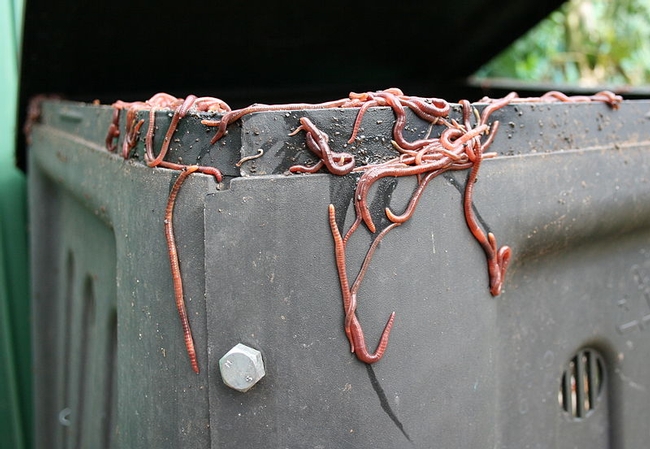My yard is covered in snow, but I am still composting here in Mammoth Lakes. I am composting my kitchen scraps indoors - with the help of compost worms. Coffee grounds, tea leaves, veggie scraps all go in the compost bins. Vermicompost is the official term for composting with worms. Vermicomposting is sometimes confused with vermiculture which is the process of raising worms.
The most commonly used worms for composting are Eisenia fetida, known as "Red Wigglers" or "Red Worms" that you can find in sporting goods stores to be used as fishing bait. You can buy worms at sporting goods stores, online, or get some from a friend who has a vermicompost setup already.

It's not the most lovely of names for such a helpful creature, but do not fear, these are very skinny little worms! I once saw an adult relative run away from an earthworm on the pavement; that really made me laugh but it also pointed out to me that some people think worms are yucky, or even scary. Compost worms, however, are really useful. Communities have reduced waste going to their landfills through composting efforts incorporating vermicomposting. In addition to reducing waste, the product of worm composting, called castings, is a nutrient rich fertilizer and a great soil conditioner. You can add it to your outdoor plantings and to houseplants. It is also easy to create “worm tea” as a liquid fertilizer. Even if you use an outdoor compost pile, vermicomposting is a great option for processing kitchen scraps.
Housing for worms is surprisingly easy to make and also to maintain. My smallest worm bin was a gift over 25 years ago; it takes up about a square foot of space. I have two other bins, the Taj Mahal of worm bins with multiple trays that I won as a door prize (thank you Master Gardeners), and another I put together as a demonstration project. The demonstration bins I made and still use are from plans for a “Cheap and Easy Worm Bin” available on the Whatcom County Washington State University Extension website http://whatcom.wsu.edu/ag/compost/Easywormbin.htm. This is a very simple homemade worm bin using plastic totes. Be sure to get opaque totes as compost worms are sensitive to light. The Whatcom County Extension website also has simple instructions on starting your worm bin and harvesting castings.
Any search on the internet will bring up many enthusiastic articles related to vermicompost, but please don't get the idea it is complicated or difficult. You can even leave the bin and go off on a three week trip without your worms missing you. They just continue to work over what material is in the bin.
The whole process is surprisingly easy and free. Should I have mentioned free earlier? It's really hard to beat free! Once you have purchased your bin and starter worms, the rest is free and the resulting product is a high quality soil amendment that also reduces waste to our local landfill, your plants will love you for it.
In my next articles on vermicompost, I will cover the particulars of maintaining a compost worm bin, using castings and creating worm tea.
Further information including a list of suppliers can be found at www.calrecycle.ca.gov/Organics/worms/WormFact.htm
Another good resource is: http://www.bae.ncsu.edu/topic/vermicomposting/
For information on our local soils go to the section entitled “Eastern Sierra Gardening Info” in the UCCE Master Gardeners of Inyo and Mono counties' homepage at http://ucanr.edu/sites/mginyomono.